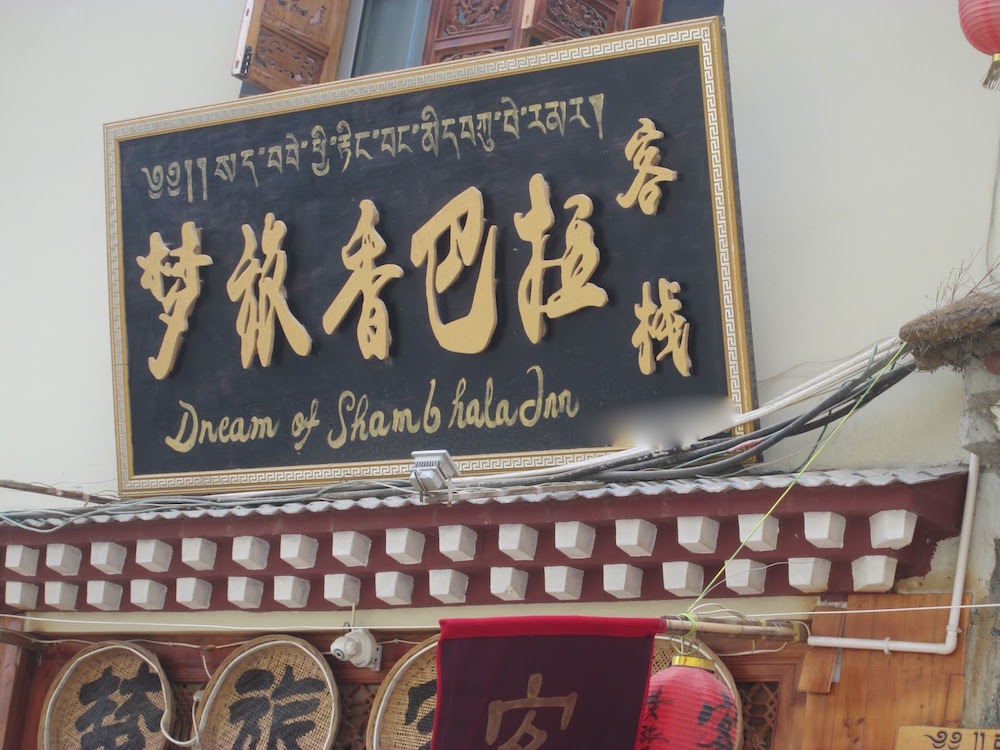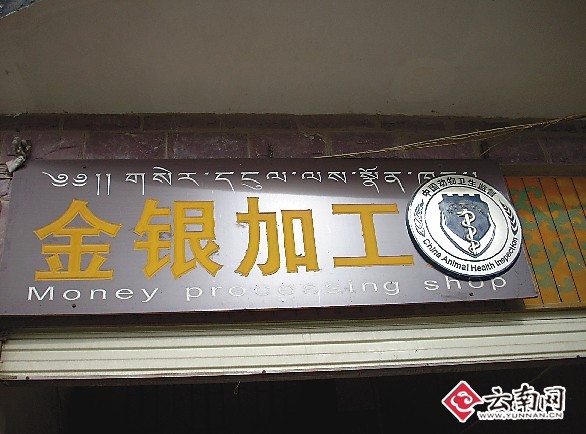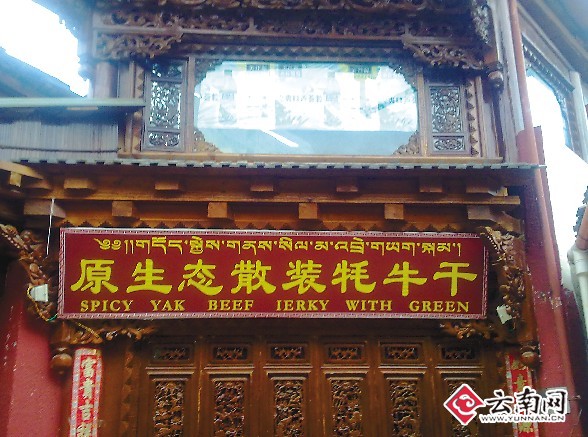Gibberish Tibetan
« previous post | next post »
Sign on an inn in Shangri-La, Yunnan, China:
The Chinese, which is primary, says:
Mèng lǚ Xiāngbālā kèzhàn 夢旅香巴拉客栈
("Shambhala dream journey inn")
The English is a more or less passable translation of the Chinese, but the Tibetan is a terrible jumble that means nothing, at least nothing that is readily discernible:
sang babe phyi rting bang ming bku be rmar
(in Wylie transcription that would be: sad bbe phyi rting bang mid bku be r.mar).
Nathan Hill (source of the first transcription in the previous sentence) observes:
babe and rmar (or maybe I should have transliterated ramar) are not possible Tibetan syllables.
Sang ba certainly makes you think they are trying to transliterate Shambala. Some of the rest of the words are individually meaningful, but I have no idea what is being 'expressed' by the whole.
Robbie Barnett:
…I am not sure it means anything. Of the 8 syllables, 3 are not possible letter-combinations in Tibetan. If we assume that some punctuation is missing, then still two syllables are impossible combinations. The remaining syllables could be read as fragments of words that might mean frost-xx-heel-storehouse-throat-juice-xx. But they could be seen as fragments of words meaning dozens of other things too. They do not sound anything like meng or Xiangbala and cannot be an attempt to sound that out. Nor do they include anything that resembles the Tibetan words for "dream", "inn" or "Shambhala". So I have no idea. Maybe it's a secret code.
The above picture occurs in this post by Tibetologist Dan Martin (=Dan Yerushalmi [source of the Wylie transliteration cited above]) about the faux-Tibetan town of Shangri-La.
The odd thing is that, although the Tibetan on the sign is alphabet soup, the painted lettering is of quite good quality.
After asking his erudite colleague Gedun Rabsal to see if he could figure out what the intended wording was supposed to be, Elliot Sperling remarked:
Rabsal wrote back to me that he can’t make out any meaning, even wondering if it’s supposed to be something Chinese, written in Tibetan script.
Of course, we can see that the writing in places doesn’t reflect Tibetan spelling. Given that it is required in the Tibet Autonomous Region (TAR) and other Tibetan autonomous units that signs include the language of the “autonomous” people, and that Tibetans are often hired to do the script for Chinese who almost never (or simply never) learn the local language, I wouldn’t be surprised if a little passive aggression went into turning out this gibberish.
If one honestly wanted to translate the Chinese into Tibetan, it would, per Leonard van der Kuijp, be:
sham baha la'i mgron khang gyi rmi lam ཤམ་བཧ་ལའི་མགྲོན་ཁང་གྱི་རྨི་ལམ་
(bearing in mind that the second syllable should have a subscribed ཧ)
This translation implies "dream which is a hotel of Shambala", though it would also be possible to interpret the name as "hotel which is the dream of Shambala".
Additional notes from Robbie Barnett:
I think the transliteration could more likely be:
sad b[a]be phyi rting bang midbku be r[a]mar
i.e., mid and bku appear as a single word; what you read as -ng is actually a -d, I would say, from comparison with "rting" and "bang", where the -ng has a shorter tail and longer spine than the -d; the rmar is an impossible combination unless the r is a superscript/head letter, so it is guesswork as to whether to impute a vowel to it. There is a superscript r on the rting, so it is not that the writer was unaware of this practice.
What I've written as [a] just means that I think this syllable is alphabet soup, as far as I know, an impossible or unlikely letter-combination.
sham baha la'i mgron khang gyi rmi lam ཤམ་བཧ་ལའི་མགྲོན་ཁང་གྱི་རྨི་ལམ་ – this looks right to me, though wouldn't it mean 'dream of the inn of shambhala'? In other words, you might want to change the word order.
The usual way to refer to Shambhala in Tibetan is as bde 'byung བདེ་འབྱུང ("bliss-arising" or "source / arising of happiness"), which may lead us to think of the pure lands (paradises) of the buddhas.
Shangri-La (not to mention other exotic tourist destinations in China) is full of such fake "minority" language signs. Below are three examples from a 9/8/10 Xinhuanet article. In these cases of multiple mangling, I will not explicate the Chinese and the Tibetan, such as it is, but just let the cockeyed Chinglish speak for itself.
It is not clear to me why this "Money processing shop" is operating under the auspices of China Animal Health Inspection.
At least they didn't translate the gān 干 ("dry") as gàn 干 ("fuck").
The main problem here arises from splitting yīnxiàng 音像 ("audio and video") into "sound" and "be / look like; resemble").
Earlier posts about Uyghur as decoration:
- "Gibberish Uyghur" (9/28/09)
- "Uyghur as ornament" (9/19/13)
These posts on Tibetan may also be of interest:
- "Tibetan –> Chinese –> Chinglish" (11/11/15)
- "Hide the satisfied store in statue of Buddha" (7/18/12)
[Thanks to Jichang Lulu, Douglas Duckworth, and Matthew Kapstein]




Victor Mair said,
October 6, 2016 @ 10:51 pm
From Douglas Duckworth:
For the gibberish, your rendition is close, but
>> sad babe phyi rting bang mid bku be rma
is what it appears to say (final ng and d are sometimes confused, which is how your rendition had it).
བདེ་བྱུང་ means: "source of happiness" (བདེ་ = happiness; བྱུང = arise; source)
John Rohsenow said,
October 6, 2016 @ 11:23 pm
Of course in the mid 20th C there was a lot of "Chinese characters asornamentation" in western publications and films. As I recall, the Belgiancartoonist Herge' s TINTIN strip was a notable exception.
Matt said,
October 7, 2016 @ 2:46 am
A side issue, but I think the English on that sign is better than passable — it's really quite good! The "Dream of Shambhala" sounds exactly like the sort of establishment that would appear in a Victorian mystic's memoirs.
Jichang Lulu said,
October 7, 2016 @ 9:58 am
Don't know what WordPress will do to it, but here's Shambhala with subscript h: ཤམ་བྷ་ལ།
The *bBe Sign is truly mysterious. This isn't the average mistranslation. As I commented on Tibeto-logic, I think the text has been copied by someone not literate in Tibetan who could have mixed up similar-looking letters (e.g. *bbe བབེ་ could be bde བདེ་ 'bliss', *r.mar རམར་ could be dmar དམར་ 'red'), but even allowing for that sort of ambiguity a plausible original text fails to emerge (considering several experts have looked into it). There's also the mojibake hypothesis: input method misuse/font issues rendering an underlyingly correct Tibetan original as gibberish. But that would normally produce even worse gibberish than the sign, which does include legitimate segments. I did try to think as the sign maker and checked some (broken) online tools in Chinese, but that failed to reproduce anything resembling this.
Here's a clearer picture of the sign. I hope Messrs Dream of Shambhala don't mind the mobile number hasn't been blurred, they're getting free publicity after all.
Shangri-la isn't just a faux-Tibetan town. It's a faux-Tibetan town built astride a real Tibetan town, Rgyalthang རྒྱལ་ཐང་, part of which can be seen in the Tibeto-logic post.
Jichang Lulu said,
October 7, 2016 @ 10:23 am
I think I meant this picture.
Victor Mair said,
October 8, 2016 @ 1:24 pm
From Jichang Lulu:
Great post! It's quite remarkable the Bbe Sign remains opaque after being examined by such bigwigs of Tibetology (indeed starting with Dan Martin himself). I think it's on a wholly different scale compared to other mistranslations, including others in Shangri-la itself.
There's one more thing that caught my interest in Dan's Shangri-la post: the McTibetan town's own Tibetan name, སེམས་ཀྱི་ཉི་ཟླ་ sems kyi nyi zla 'Sun-Moon of the mind'. Dan himself says this is a Tibetanisation of the Sinification of the Western McTibetan name 'Shangri-la', which it ostensibly is, but he links to this article, "Paradise under Construction: Minorities, Myths and Modernity in Northwest Yunnan" (pdf) by Ben Hillman that presents how that Tibetanisation came about. It's not simply the sort of transcription used in, e.g., Sinification of Western brands (i.e., choosing nice meanings for foreign sounds without pretending there's an etymological connection); actually, the Tibetan name was 'discovered' by a team of experts that had to convince the government that Sems kyi nyi zla actually is the origin of English 'Shangri-la' to justify officially renaming the town. Isn't it just splendid? Make etymology miraculously flow backwards to open the floodgates of tourism.
(This all somehow reminds me of the [way higher-level] commission that marshaled vast areas of human knowledge to prove Sima Qian's pre-Zhou history is all scientific and correct and matches astronomy and the archeological record. It also somehow reminds me of the Soviet joke on the Pushkin monument contest: third prize, 'Stalin reads Pushkin', historically true, politically false; second, 'Pushkin reads Stalin', politically true, historically false; first prize, 'Stalin reads Stalin'.)
John Mathis said,
October 18, 2016 @ 10:44 pm
Reading "Tibetans are often hired to do the script for Chinese who almost never (or simply never) learn the local language," reminded me of when I worked for the Beijing Foreign Language Press and a friend of mine was looking for a Chinese > Tibetan dictionary. You could find Tibetan > Chinese dictionaries in Beijing, but not the other way around. When I asked my boss for help she gave me a laugh as if it was the silliest question and replied "Chinese have no reason to learn Tibetan."